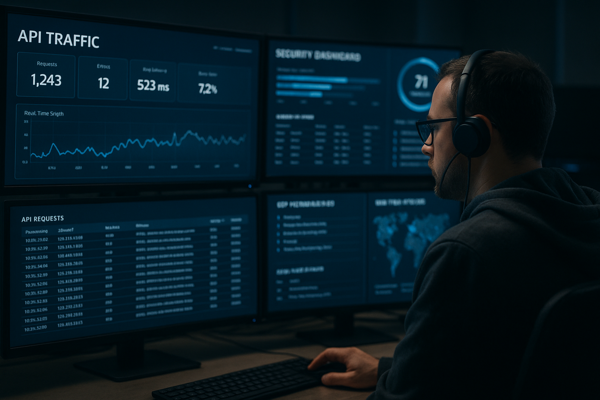In 2025, the boundary between IT and operational technology (OT) is more porous than ever. What once were siloed environments are now deeply intertwined—creating new opportunities for efficiency, but also a vastly expanded attack surface. For industrial, manufacturing, energy, and critical infrastructure operators, the stakes are high: disruption in OT is real-world damage, not just data loss.

This article lays out the problem space, dissecting how adversaries move, where visibility fails, and what defense strategies are maturing in this fraught environment.
The Convergence Imperative — and Its Risks
What Is IT/OT Convergence?
IT/OT convergence is the process of integrating information systems (e.g. ERP, MES, analytics, control dashboards) with OT systems (e.g. SCADA, DCS, PLCs, RTUs). The goal: unify data flows, enable predictive maintenance, real-time monitoring, control logic feedback loops, operational analytics, and better asset management.
Yet, as IT and OT merge, their worlds’ assumptions—availability, safety, patch cycles, threat models—collide. OT demands always-on control; IT is optimized for data confidentiality and dynamic architecture. Bridging the two without opening the gates to compromise is the core challenge.
Why 2025 Is Different (and Dangerous)
-
Attacks are physical now. The 2025 Waterfall Threat Report shows a dramatic rise in attacks with physical consequences—shut-downs, equipment damage, lost output. Waterfall Security Solutions
-
Ransomware and state actors converge on OT. OT environments are now a primary target for adversaries aiming for disruption, not just data theft. zeronetworks.com+2Industrial Cyber+2
-
Device proliferation, blind spots. The explosion of IIoT/OT-connected sensors and actuators means incremental exposures mount. Nexus+2IAEE+2
-
Legacy systems with little guardrails. Many OT systems were never built with security in mind; patching is difficult or impossible. SSH+2Industrial Cyber+2
-
Stronger regulation and visibility demands. Critical infrastructure sectors face growing pressure—and liability—for cyber resilience. Honeywell+2Fortinet+2
-
Maturing defenders. Some organizations are already reducing attack frequency through segmentation, threat intelligence, and leadership-driven strategies. Fortinet
Attack Flow: From IT to OT — How the Adversary Moves
Understanding attacker paths is key to defending the convergence.
-
Initial foothold in IT. Phishing, vulnerabilities, supply chain, remote access are typical vectors.
-
Lateral movement toward bridging zones. Jump servers, VPNs, misconfigured proxies, flat networks let attackers pivot. Industrial Cyber+2zeronetworks.com+2
-
Transit through DMZ / industrial demilitarized zones. Poorly controlled conduits allow protocol bridging, data transfer, or command injection. iotsecurityinstitute.com+2Palo Alto Networks+2
-
Exploit OT protocols and logic. Once in the OT zone, attackers abuse weak or proprietary protocols (Modbus, EtherNet/IP, S7, etc.), manipulate command logic, disable safety interlocks. arXiv+2iotsecurityinstitute.com+2
-
Physical disruption or sabotage. Alter sensor thresholds, open valves, shut down systems, or destroy equipment.
Because OT environments often have weaker monitoring and fewer detection controls, malicious actions may go unnoticed until damage occurs.
The Visibility & Inventory Gap
You can’t protect what you can’t see.
-
Publicly exposed OT devices number in the tens of thousands globally—many running legacy firmware with known critical vulnerabilities. arXiv
-
Some organizations report only minimal visibility into OT activity within central security operations. Nasstar
-
Legacy or proprietary protocols (e.g. serial, Modbus, nonstandard encodings) resist detection by standard IT tools.
-
Asset inventories are often stale, manual, or incomplete.
-
Patch lifecycle data, firmware versions, configuration drift are poorly tracked in OT systems.
Bridging that visibility gap is a precondition for any robust defense in the converged world.
Architectural Controls: Segmentation, Microperimeters & Zero Trust for OT
You must treat OT not as a static, trusted zone but as a layered, zero-trust-aware domain.
1. Zone & Conduit Model
Apply segmentation by functional zones (process control, supervisory, DMZ, enterprise) and use controlled conduits for traffic. This limits blast radius. iotsecurityinstitute.com+2Palo Alto Networks+2
2. Microperimeters & Microsegmentation
Within a zone, restrict east-west traffic. Only permit communications justified by policy and process. Use software-defined controls or enforcement at gateway devices.
3. Zero Trust Principles for OT
-
Least privilege access: Human, service, and device accounts should only have the rights they need to perform tasks. iotsecurityinstitute.com+1
-
Continuous verification: Authenticate and revalidate sessions, devices, and commands.
-
Context-based access: Enforce access based on time, behavior, process state, operational context.
-
Secure access overlays: Replace jump boxes and VPNs with secure, isolated access conduits that broker access rather than exposing direct paths. Industrial Cyber+1
4. Isolation & Filtering of Protocols
Deep understanding of OT protocols is required to permit or deny specific commands or fields. Use protocol-aware firewalls or DPI (deep packet inspection) for industrial protocols.
5. Redundancy & Fail-Safe Paths
Architect fallback paths and redundancy such that the failure of a security component doesn’t cascade into OT downtime.
Detection & Response in OT Environments
Because OT environments are often low-change, anomaly-based detection is especially valuable.
Anomaly & Behavioral Monitoring
Use models of normal process behavior, network traffic baselines, and device state transitions to detect deviations. This approach catches zero-days and novel attacks that signature tools miss. Nozomi Networks+2zeronetworks.com+2
Protocol-Aware Monitoring
Deep inspection of industrial protocols (Modbus, DNP3, EtherNet/IP, S7) lets you detect invalid or dangerous commands (e.g. disabling PLC logic, spoofing commands).
Hybrid IT/OT SOCs & Playbooks
Forging a unified operations center that spans IT and OT (or tightly coordinates) is vital. Incident playbooks should understand process impact, safe rollback paths, and physical fallback strategies.
Response & Containment
-
Quarantine zones or devices quickly.
-
Use “safe shutdown” logic rather than blunt kill switches.
-
Leverage automated rollback or fail-safe states.
-
Ensure forensic capture of device commands and logs for post-mortem.
Patch, Maintenance & Change in OT Environments
Patching is thorny in OT—disrupting uptime or control logic can have dire consequences. But ignoring vulnerabilities is not viable either.
Risk-Based Patch Prioritization
Prioritize based on:
-
Criticality of the device (safety, control, reliability).
-
Exposure (whether reachable from IT or remote networks).
-
Known exploitability and threat context.
Scheduled Windows & Safe Rollouts
Use maintenance windows, laboratory testing, staged rollouts, and fallback plans to apply patches in controlled fashion.
Virtual Patching / Compensating Controls
Where direct patching is impractical, employ compensating controls—firewall rules, filtering, command-level controls, or wrappers that mediate traffic.
Vendor Coordination & Secure Updates
Work with vendors for safe update mechanisms, integrity verification, rollback capability, and cryptographic signing of firmware.
Configuration Lockdown & Hardening
Disable unused services, remove default accounts, enforce least privilege controls, and lock down configuration interfaces. Industrial Cyber
Operating in Hybrid Environments: Best Practices & Pitfalls
-
Journeys, not Big Bangs. Start with a pilot cell or site; mature gradually.
-
Cross-domain teams. Build integrated IT/OT guardrails teams; train OT engineers with security awareness and IT folk with process sensitivity. iotsecurityinstitute.com+2Secomea+2
-
Change management & governance. Formal processes must span both domains, with risk acceptance, escalation, and rollback capabilities.
-
Security debt awareness. Legacy systems will always exist; plan compensating controls, migration paths, or compensating wrappers.
-
Simulation & digital twins. Use testbeds or digital twins to validate security changes before deployment.
-
Supply chain & third-party access. Strong control over third-party remote access is essential—no direct device access unless brokered and constrained. Industrial Cyber+2zeronetworks.com+2
Governance, Compliance & Regulatory Alignment
-
Map your security controls to frameworks such as ISA/IEC 62443, NIST SP 800‑82, and relevant national ICS/OT guidelines. iotsecurityinstitute.com+2Tenable®+2
-
Develop risk governance that includes process safety, availability, and cybersecurity in tandem.
-
Align with critical infrastructure regulation (e.g. NIS2 in Europe, SEC cyber rules, local ICS/OT mandates). Honeywell+1
-
Build executive visibility and metrics (mean time to containment, blast radius, safety impact) to support prioritization.
Roadmap: From Zero → Maturity
Here’s a rough maturation path you might use:
| Phase | Focus | Key Activities |
|---|---|---|
| Pilot / Awareness | Reduce risk in one zone | Map asset inventory, segment pilot cell, deploy detection sensors |
| Hardening & Control | Extend structural defenses | Enforce microperimeters, apply least privilege, protocol filtering |
| Detection & Response | Build visibility & control | Anomaly detection, OT-aware monitoring, SOC integration |
| Patching & Maintenance | Improve security hygiene | Risk-based patching, vendor collaboration, configuration lockdown |
| Scale & Governance | Expand and formalize | Extend to all zones, incident playbooks, governance models, metrics, compliance |
| Continuous Optimization | Adapt & refine | Threat intelligence feedback, lessons learned, iterative improvements |
Start small, show value, then scale incrementally—don’t try to boil the ocean in one leap.
Use Case Scenarios
-
Remote Maintenance Abuse
A vendor’s remote access via a jump host is compromised. The attacker uses that jump host to send commands to PLCs via an unfiltered conduit, shutting down a production line. -
Logic Tampering via Protocol Abuse
An attacker intercepts commands over EtherNet/IP and alters setpoints on a pressure sensor—causing shock pressure and damaging equipment before operators notice. -
Firmware Exploit on Legacy Device
A field RTU is running firmware with a known remote vulnerability. The attacker exploits that, gains control, and uses it as a pivot point deeper into OT. -
Lateral Movement from IT
A phishing campaign generates a foothold on IT. The attacker escalates privileges, accesses the central historian, and from there reaches into OT DMZ and onward.
Each scenario highlights the need for segmentation, detection, and disciplined control at each boundary.
Checklist & Practical Guidance
-
⚙️ Inventory & visibility: Map all OT/IIoT devices, asset data, communications, and protocols.
-
🔒 Zone & micro‑segment: Enforce strict controls around process, supervisory, and enterprise connectivity.
-
✅ Least privilege and zero trust: Limit access to the minimal set of rights, revalidate often.
-
📡 Protocol filtering: Use deep packet inspection to validate or block unsafe commands.
-
💡 Anomaly detection: Use behavioral models, baselining, and alerts on deviations.
-
🛠 Patching strategy: Risk-based prioritization, scheduled windows, fallback planning.
-
🧷 Hardening & configuration control: Remove unused services, lock down interfaces, enforce secure defaults.
-
🔀 Incident playbooks: Include safe rollback, forensic capture, containment paths.
-
👥 Cross-functional teams: Co-locate or synchronize OT, IT, security, operations staff.
-
📈 Metrics & executive reporting: Use security KPIs contextualized to safety, availability, and damage containment.
-
🔄 Continuous review & iteration: Ingest lessons learned, threat intelligence, and adapt.
-
📜 Framework alignment: Use ISA/IEC 62443, NIST 800‑82, or sector-specific guidelines.
Final Thoughts
As of 2025, you can’t treat OT as a passive, hidden domain. The convergence is inevitable—and attackers know it. The good news is that mature defense strategies are emerging: segmentation, zero trust, anomaly-based detection, and governance-focused integration.
The path forward is not about plugging every hole at once. It’s about building layered defenses, prioritizing by criticality, and evolving your posture incrementally. In a world where a successful exploit can physically damage infrastructure or disrupt a grid, the resilience you build today may be your strongest asset tomorrow.
More Info and Assistance
For discussion, more information, or assistance, please contact us. (614) 351-1237 will get us on the phone, and info@microsolved.com will get us via email. Reach out to schedule a no-hassle and no-pressure discussion. Put out 30+ years of OT experience to work for you!
* AI tools were used as a research assistant for this content, but human moderation and writing are also included. The included images are AI-generated.



